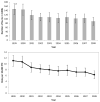Occupational burns treated in emergency departments
- PMID: 25678457
- PMCID: PMC4528302
- DOI: 10.1002/ajim.22407
Occupational burns treated in emergency departments
Abstract
Background: Despite reported declines, occupational burn injuries remain a workplace safety concern. More severe burns may result in costly medical treatment and long-term physical and psychological consequences.
Methods: We used the National Electronic Injury Surveillance System-Occupational Supplement to produce national estimates of burns treated in emergency departments (EDs). We analyzed data trends from 1999 to 2008 and provided detailed descriptions of 2008 data.
Results: From 1999 to 2008 there were 1,132,000 (95% CI: ±192,300) nonfatal occupational burns treated in EDs. Burn numbers and rates declined approximately 40% over the 10 years. In 2008, men and younger workers 15-24 years old had the highest rates. Scalds and thermal burns accounted for more than 60% of burns. Accommodation and food service, manufacturing, and construction industries had the largest number of burns.
Conclusions: Despite declining burn rates, emphasis is needed on reducing burn hazards to young food service workers and using job specific hazard analyses to prevent burns.
Keywords: burns; construction injuries; food service injuries; nonfatal; occupational injuries.
© 2015 Wiley Periodicals, Inc.
Conflict of interest statement
Disclosure Statement: The authors report no conflicts of interests.
Figures
References
-
- ABA. [Accessed May 20, 2014];National Burn Repository: Report of data from 2001–2010. 2011 Available from: http://www.ameriburn.org/2011NBRAnnualReport.pdf.
-
- ABA. [Accessed May 20, 2014];Burn incidence and treatment in the United States: 2013 fact sheet. 2013 Available from: http://www.ameriburn.org/resources_fact-sheet.php.
-
- ANSI/International Safety Equipment Association (ISEA) Z87.1–2010. American national standard for occupational and educational eye and face protection devices. 2010.
-
- Baggs J, Curwick C, Silverstein B. Work-related burns in Washington State, 1994 to 1998. J Occup Environ Med. 2002;44:692–699. - PubMed
-
- BLS. Occupational injury and illness classification manual. Washington DC: U.S. Department of Labor; 1992.
MeSH terms
Grants and funding
LinkOut - more resources
Full Text Sources
Other Literature Sources
Medical


